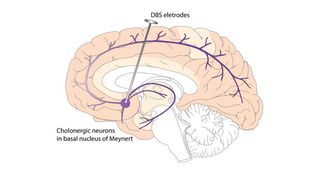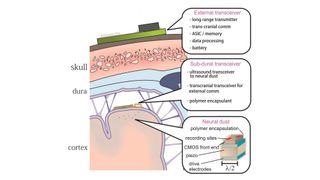Elon Musk’s Neuralink – everything you need to know
Supercharging your grey matter

We've all been in that situation where the remote control is just out of reach, you’ve managed to settle perfectly into your sofa groove, Netflix is asking if you’re still watching, and – no matter how much you scream “Of course I am, stop judging me!” – your next episode of Ru Paul’s Drag Race just won’t start.
If only there was a way to control your TV using your mind. Well, one day there may well be, thanks to billionaire inventor Elon Musk. You know Musk – the guy behind Tesla, SpaceX, and Hyperloop. The guy the whole world is collectively keeping their fingers crossed doesn't turn out to be a real-life Lex Luthor.
Musk has created a company called Neuralink, which is working on putting brain-computer interfaces (BCIs) into our skulls.
Your BCI will likely be much more than just a way for you to control whatever streaming service you use. It will potentially be a way for you to communicate with your loved ones, search the web, and interact with your symbiotic AI. It could even replace your television, streaming content straight into your brain.
While those possibilities are far off, BCIs aren’t. They're already helping the deaf to hear, Parkinson's sufferers to alleviate their symptoms and the paralyzed to move robotic limbs. More on that below.
Neuralink is still in very early stages, and so actual product information is practically non-existent. What we're doing with this piece is explaining what the plans are for Neuralink, where the technology currently is, and when we're likely to actually see a working Neuralink device.
As you can imagine, the whole subject of brain computer interfaces is pretty complicated, so in order to explain what Musk's plans are in a way that will actually make sense, we're going to explain a bit about how your brain works, how BCIs work, and then get on to Neuralink.
Get daily insight, inspiration and deals in your inbox
Get the hottest deals available in your inbox plus news, reviews, opinion, analysis and more from the TechRadar team.
It’s a wild ride, so strap in.
I gots me a brain
Inside your noggin is a wobbly nugget of grey matter that is responsible for everything you know to be true. The world that you are experiencing as ‘other’ only exists thanks to sensory inputs that your body is passing to your brain, which it then processes and compiles into a collection that you call ‘reality’.
For our first massive understatement of this article we offer this: brains are complicated. In recent years neuroscientists have come a long way in understanding the complexity of our brains, but we are still a long way off knowing exactly what’s happening inside the electric engine in our skull.
To take a quote from The Biological Origin of Human Values by George Edgin Pugh: “If the human brain were so simple that we could understand it, we would be so simple that we couldn’t.”

That's not to say that we know nothing about our brains, we have managed to roughly identify the different sections of the brain, and more importantly what those different sections of the brain do.
To massively oversimplify it, our brain is divided into two main sections, the limbic system and the neocortex. The limbic system is the primitive part of the brain that's responsible for all of our more primal urges – eating, fighting, sex. All the survival-y parts.
The neo-cortex is the lumpy top bit that you’ve probably been picturing every time you’ve read the word 'brain' in this article. The neocortex is the advanced part of our brain responsible for art, business, technology, philosophy, and Pokemon Go.

What might surprise you about the neocortex is that all that thought power doesn’t actually happen in the main ‘belly’ (for lack of a better word) of the neo-cortex, but in a two-millimeter thick layer on top. The rest of that mass underneath is effectively just wiring.
We have done a significant amount of mapping of the neocortex thanks to developments in brain scanning technology like functional magnetic resonance imagery (fMRI). This is a technique that enables clinicians and researchers to see the inner workings of the brain by studying real-time blood flow while the brain is working using magnetic fields.
Brain-computer interfaces
What this has meant is that we’ve been able to identify (among other things) which parts of the motor cortex move different parts of our body, and which parts of our somatosensory cortex receive senses from different body parts, which in turn makes possible the creation of increasingly efficient medical and other devices.
By implanting BCIs into a small patch of the surface level of the brain, for example, paralyzed patients are able to move robotic limbs by simply thinking about moving their own paralysed limb. This nerve signal is received by the BCI, and the command is then carried out by the robotic limb.
The only way to fully appreciate how incredible this is is to see it in action – and you can do so in this video from the Brown Institute for Brain Science:
But BCIs don’t only work with signals coming out of our brains, they can also potentially be used to put information in there.
We aren’t at the stage yet where sensory information can be fed directly into the brain, but we are at the stage where, for example, a computer can send signals to nerves in the cochlea to enable people with hearing loss to hear again.
For patients that have profound hearing loss, a cochlea implant can prove life-changing. A small speaker sits on the outside of the skull, and feeds a digital signal to a small computer that sits inside the cochlea, which sends the nerve signals relating to sound to the brain.
There are BCIs called deep brain stimulation devices that currently send electrical signals directly into the brain, but they aren’t quite at the stage of being true nerve signals just yet. For Parkinson’s sufferers, deep-brain stimulation is the main form of treatment for alleviating symptoms.

This uses a number of small electrodes inserted surgically into the brain, with wires that trail out of the skull to a small control box. When activated, the electrodes pass a small electrical current through the section of the brain that reduces the severity of the tremors associated with Parkinson's.
So BCIs are at the moment fairly crude, but this technology is a field that is rapidly growing – and the predictions for what it will be capable of are pretty astounding.
Where BCIs are heading
Chip manufacturer ARM is currently working on a chip that will be implanted into the brain, which it hopes will be able to bridge injuries in the spinal column of patients, allowing for the transfer of nerve signals both from and to the brain, giving patients back the ability to not only move their limbs, but regain feeling in those limbs.
It's quite possible that Neuralink will be working on a similar goal, at least as one part of its strategy, to start with, but we’ll get on to that in a little bit.
For now, it’s important to understand that the overarching goal of Neuralink is to create a device that goes way beyond the basic uses of a BCI, which at the moment are specific-task machines – they have one function, that relates to one part of the brain.
What Neuralink will be – if it succeeds – is a whole-brain BCI that's capable of transmitting signals to and receiving signals from any part of the brain. It would be an integrated ‘digital tertiary layer’. We would become cyborgs.
According to Musk, this isn’t too great a leap from where we currently are in the stage of human development. In an interview with Wait But Why Musk said: “We already have a digital tertiary layer in a sense, in that you have your computer or your phone or your applications. You can ask a question via Google and get an answer instantly. You can access any book or any music. With a spreadsheet, you can do incredible calculations.
“If you had an Empire State Building filled with people – even if they had calculators, let alone if they had to do it with a pencil and paper – one person with a laptop could outdo the Empire State Building filled with people with calculators.
“The thing that people, I think, don’t appreciate right now is that they are already a cyborg. You’re already a different creature than you would have been 20 years ago, or even 10 years ago. You can see this when they do surveys of like, 'how long do you want to be away from your phone?' and – particularly if you’re a teenager or in your 20s – even a day hurts. If you leave your phone behind, it’s like missing limb syndrome. I think people – they’re already kind of merged with their phone and their laptop and their applications and everything.“
So Neuralink would end up taking all the external devices that make us a cyborg, and put them straight into our brain.
Communication
What this digital tertiary layer would mean is that our brains would be able to bypass communication in the way that we currently know it. Language, in both its written and spoken forms, are a construct that we've created in order to convey meaning, but it's an imperfect system.
As Musk put it in the aforementioned interview: “There are a bunch of concepts in your head that your brain has to try to compress into this incredibly low data rate called speech or typing.
“That’s what language is – your brain has executed a compression algorithm on thought, on concept transfer. And then it’s got to listen as well, and decompress what’s coming at it. And this is very lossy as well.”

This also goes for the way in which we communicate with the devices we use, but also for how we communicate with each other. If numerous people with a Neuralink wanted to communicate with one another, they would be able to communicate on a level that comes before (or goes beyond) language.
“If you have two brain interfaces, you could actually do an uncompressed direct conceptual communication with another person,” Musk added. “If I were to communicate a concept to you, you would essentially engage in consensual telepathy. You wouldn’t need to verbalize unless you want to add a little flair to the conversation or something, but the conversation would be conceptual interaction on a level that’s difficult to conceive of right now.”
He’s not wrong that it’s difficult to conceive of. Of course language isn’t the only method of communication available to us, but trying to imagine a conversation purely in concepts is nearly impossible.
Racing the singularity
One of the most significant things that Musk thinks Neuralink will do is stave off fears of the singularity. The singularity is the moment when artificial intelligence overtakes human intelligence, and it's something that strikes fear into the hearts of those who think about it (try not to think of the Terminator, try not to think of the Terminator) – and no one more than Musk.
He's been warning us about the dangers of AI for many years, making such bold claims as “We’re gonna win the Darwin Award, collectively,” and saying that AI poses a greater risk than North Korea…
If you're not concerned about AI safety, you should be. Vastly more risk than North Korea. pic.twitter.com/2z0tiid0lcAugust 12, 2017
AI is getting more powerful and more efficient at what seems like a daily rate, and now that we’re in a position where AIs are learning from themselves, there may soon come a time when an AI learns how to learn better than we learn – and before we know it our intelligence will pale in insignificance compared to the awesome computational power of the digital uber-brain.
But Musk thinks there's a solution that can prevent us from becoming merely the meat-slaves of our robot overlords.
Speaking to Wait But Why, he said: “If the AIs are all separate, and vastly more intelligent than us, how do you ensure that they don’t have optimization functions that are contrary to the best interests of humanity? … If we achieve tight symbiosis, the AI wouldn’t be “other” – it would be you.
“We’re going to have the choice of either being left behind and being effectively useless or like a pet – you know, like a house cat or something – or eventually figuring out some way to be symbiotic and merge with AI.”
So that’s the big plan. Our BCI wouldn’t just be the way we communicate with machines, it would be the way we merge with machines. We would be able to search the internet with our minds, to watch video in our minds.
There’s even the possibility that audio and video content wouldn’t be experienced in the same way as it is now. If content can be streamed directly to the sensory cortex, it would be theoretically possible for music to be streamed into your head as if you were actually at the concert.
But before we fall too far down this particular rabbit hole, let’s get back to the actual science…
How it’s going to work
There are a number of different methods for creating a whole-brain BCI, but as you’d probably imagine they're all in an experimental stage.

Silk based brain-electrodes
Back in 2010, a team of scientists discovered that when they placed electrodes onto an ultra-thin silk-based polymer, the electrodes could wrap around the curvature of the cortex.
This was important, because it meant that accurate brain readings could be taken without having to risk causing damage to the brain by implanting sensors in the surface of the cortex.
Tested on a cat’s brain, the BCI faithfully detected neural activity for about a month without causing inflammation.
Inflammation is an interesting problem that BCIs face, as any foreign object that gets put into the body runs the risk of being rejected, and inflammation on the brain is obviously something to be avoided.
Neural dust
Yes, we did say 'neural dust'. This is an idea that was proposed by one of the core Neuralink team, S J Seo, during his time at Cornell University.
The basic principle is that the BMI would consist of thousands of microscopic independent sensor nodes, and one 'sub-cranial interrogator' that connects and powers them.

One of the obvious problems Neuralink will face is the current way that redundancy works in technology. With innovation happening at such a rapid rate, technology becomes obsolete within a few years of being released.
That’s not a massive problem when it’s a handheld device that you can throw away, but it's a more significant issue when the device is in your head. According to the paper, this is one problem that the team behind neural dust was trying to overcome.
Having a device in your head also poses a problem in terms of power. Having wires trailing out of your head isn't ideal, although it would be tolerable if the BCI device was mitigating debilitating symptoms; but a mainstream device, worn day-in, day-out by many people would need to be self-powering in order to be viable. It would also need to require no hardware updates, and be non-invasive to implant.
Musk has drawn comparisons with another technology that originally would have struck fear into the hearts of those hearing about it, but which is now incredibly common: Lasik laser eye surgery.
“The machine to accomplish this [implanting a BCI] would need to be something like Lasik, an automated process – because otherwise you just get constrained by the limited number of neurosurgeons, and the costs are very high,“ he told Wait But Why. “You’d need a Lasik-like machine ultimately to be able to do this at scale.”

Injectible neural mesh
One such solution for implanting a BCI in as non-invasive a way as possible could be using injectible neural mesh.
During tests on mice, researchers have managed to inject a rolled-up polymer net through a millimeters-thin needle, which then spreads out when inside the cranial cavity.
This neural mesh unfurls and covers the cortex, with tiny electrodes imbedded at the convergence points on the net that can be used to detect neural activity.
The mice in the test managed to maintain normal healthy brain function for five weeks after the test, although we don't know whether that's good news or bad news; it’s presumably good, but the team didn't elaborate on what happened after that period.
Who’s working on it
At present, Neuralink has a core team made up of a multidisciplinary group that includes chip designers from IBM’s SyNAPSE project, biocompatible material experts, neurosurgeons, BMI experts, and Musk himself.
The team has a broad range of researchers, engineers and surgeons, covering many of the fields that will be necessary to implement Neuralink’s plan of creating widely-adopted whole-brain BCIs.
What’s more, if you're currently looking for a new career, Neuralink is currently hiring. On its website it's listing jobs for digital chip designer, hardware system engineer, mechanical engineer, mechatronics engineer, recruiter, and software and systems engineers.
When are we going to actually see it?
This is an interesting question – and the estimates vary wildly depending on who you talk to.
Musk’s plan for Neuralink is that, first and foremost, it will help those in the most need: “The first use of the technology will be to repair brain injuries as a result of stroke or cutting out a cancer lesion, where somebody’s fundamentally lost a certain cognitive element,“ he told Wait But Why.
“It could help with people who are quadriplegics or paraplegics by providing a neural shunt from the motor cortex down to where the muscles are activated. The medically advantageous elements of this for dealing with mental disablement of one kind or another, which of course happens to all of us when we get old enough, are very significant.”
For those applications, Musk thinks we’re not far away at all: “We are aiming to bring something to market that helps with certain severe brain injuries (stroke, cancer lesion, congenital) in about four years.”
Beyond that, the jury is out. There is a law that corresponds to Moore’s law, which states that the number of simultaneously recorded neurons has doubled every seven years. That could mean that we’re anywhere between 25 and 50 years from having a mainstream device.
Musk has different ideas: “I think we are about eight to 10 years away from this being usable by people with no disability … It is important to note that this depends heavily on regulatory approval timing and how well our devices work on people with disabilities.”
That may seem ambitious, but then cast your mind back a few years, to when Musk’s announcement that he was going to create electric cars was met with derision. As this technology develops we'll keep this page updated, so keep checking back for all things Neuralink.
Andrew London is a writer at Velocity Partners. Prior to Velocity Partners, he was a staff writer at Future plc.
Most Popular



